To purchase the finished painting or print, click here

Acrylic, 2016, Flowerfield on a Cloudy Day
So today I’m going to write a step by step tutorial on this painting. First we will need to get some basic materials required to finish this painting, that will be:
a set of acrylic painting with extra white paint just in case
a set of brushes, and a glass of water (NOT TO DRINK FROM!)
one drawing pencil, preferably HB or 2B
a canvas (preferably 10in x 8in. I always suggest beginners to start with smaller canvases)
some nice music that helps you focus (PS: I will talk more about how to set a comfortable workplace in later posts)
a solid surface or an easel to place your canvas on.
Now let’s get going.
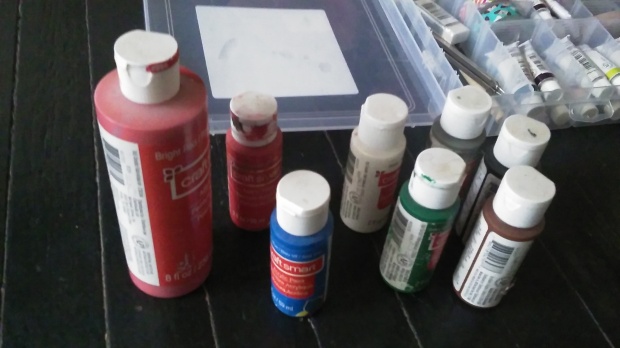
Step 1: Let’s pick out the color and brushes we are going to use. Here I picked out Red, Blue, Brown/Maroon, Green, Grey, and White.
For brushes, I picked two smaller point tip brushes, one larger-size round tip, and one larger-size flat.

Step 2: Outline with drawing pencil on the canvas what we are going to paint. All we need is lines separating the sky from the flower field, and sky from the faraway mountains. (I wasn’t able to take a picture of this step as it was a little dark in my room so I couldn’t clearly capture the pencil line)
Step 3: Paint the sky.
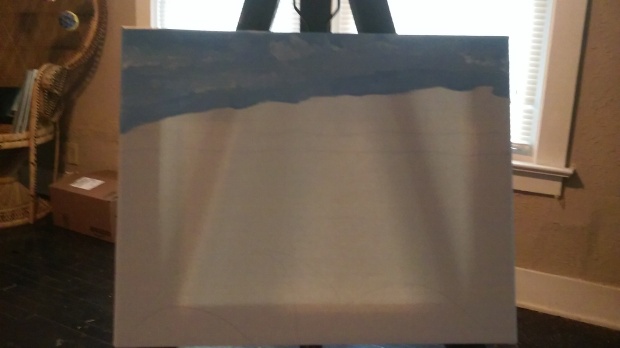
Mix blue, grey and white color together and thickly apply to the sky part that you outlined with the flat brush. Wait till it dries a little bit, then use the side of the flat brush, dip in blue and white and create a lighter color. Randomly and slightly brush through to create a cloudy effect. You can use a hair-dryer to blow dry your paint. It is much efficient than simply sitting and wait for it to dry especially on moist days.
Step 4: Paint the mountains

Now we are going to move to the mountains. Make sure your sky was completely dried (or blow-dried, lol) before you move on to this step. Mix blue, grey and a little white to create a heavier color. Still using the flat brush, heavily apply it to the top layer of mountain. Then, add more grey and blue, and thickly make the second layer.
You don’t have to wait for the top half mountain to completely dry to apply the bottom half this time. This way we create a natural transition between different values of color and achieve a natural monochrome combination.
Step 5: Paint the background color for the grass
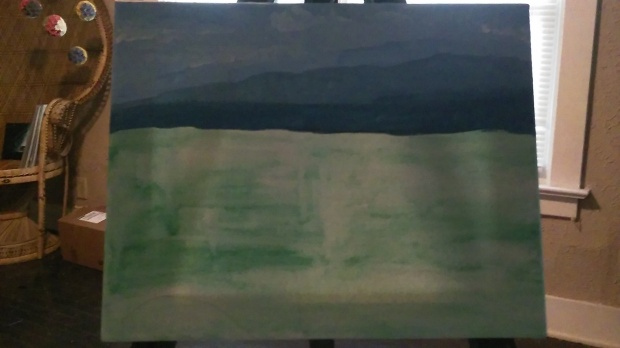
Use a wet brush, and paint a thin layer of green. You might notice how quickly the canvas sucks in the water, so be sure to keep putting more water into the paint. Notice the random texture and light color that seems quite similar to watercolor? This technique is called wash. I will talk about it a little more in different posts later. Now don’t worry about the inconsistency of this part. We will cover most of this part later.
Step 6: Grass/Flower stems
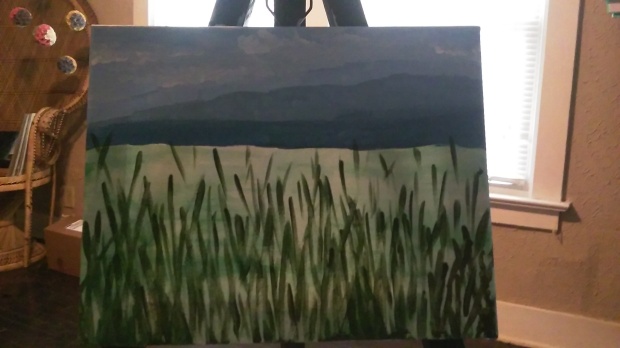
Use a smaller pointy brush and mix green and brown together. Randomly put up stems as guidance for the direction of your flowers. There are two things you need to pay attention to at this point: Make sure your stems are consistent, which means we don’t want weird, horizontal ones that doesn’t fit the law of nature… Also, the density of stems should be larger at the bottom and lighter closer to the horizontal line.
Step 7: flowers
Before doing this, make sure your grass were completely dried! Go eat a cookie, stand up and move around, since we have the longest and most tedious part of this project coming up!
Now mix red and blue, and create a dark purple color (if you have dark purple, then skip this step.)
Next, use the dry small pointy brush. Dip it in the purple and closely dot out the top layer of flower. When you are doing this, make sure you are going alone the (imaginary) stem direction. Think about lavenders. That is how your flower petals should look like.
Be aware that during this section we always wait till the precedent layer is nearly completely dry before moving on. This will take a while, but believe me it worth the patience.
Now mix in some more red, and maybe a little bit white. Dot on a second layer. We are gonna go from dark to light on the top section of the flower field.
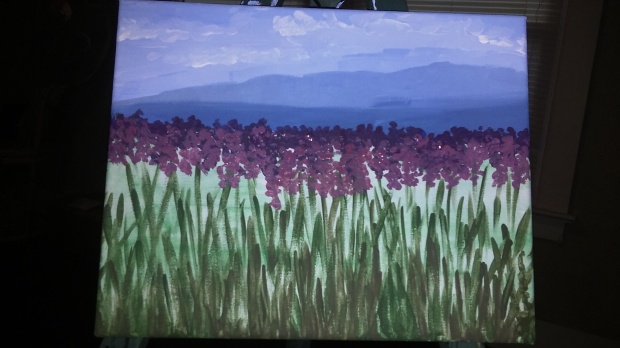
You should have something like this. This is the top part of the field. Blow dry or wait till it is completely dried. Then we are going to start another layer of flower. Mix out really violet-pink. Dot it on. Wait, and dot on some red. Wait, then dot on some really bright pink to lighten it up.
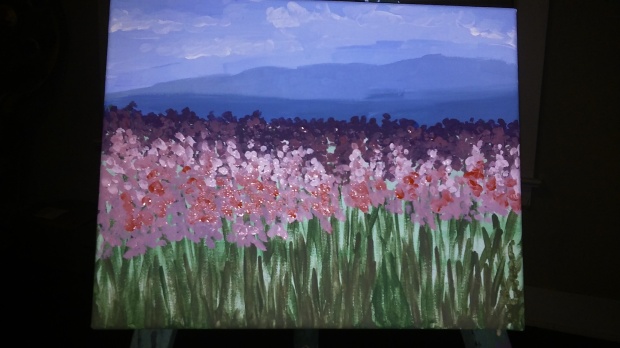
This is how it looks. Again, stand up and go eat some icecream, or do some dishes, or simply stretch your body. By the time you are through with that, your painting should be dried.
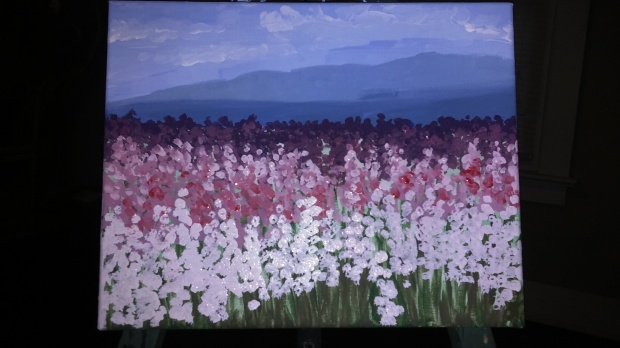
Change to the larger round tip brush.
Mix out light white-pink. With dry brush tip, adapt and dot the paint onto the canvas. You want the paint to be thick so you get a nice texture. Keep waiting. Let it dry. It’s looking better, isn’t it?
Okay now bad news, I forgot to take the step pictures from now on… So I will try my best to explain how it jumped from this picture above to the picture below…
First, mix out the peach color, and dot it on. When you’re doing this, make sure it kind of goes around the white pink we just dotted. Then, wait until it is half-dry, and add more red into your paint, and apply it following the same route. Imagine you are adding shadow to a drawing of tower! Then make heavy, dark purple, keep dotting the rest of the field to create a strong contrast of color.
And Voila!
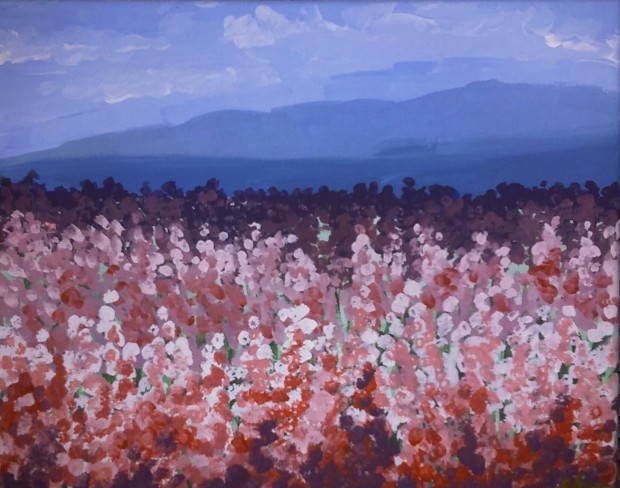
Tips:
- I recommend you to paint the edge as you are moving on if you’re using a stretched canvas like I did. It gives you the best consistency of color, and saves you the trouble of coming back and remix the color.
- Hair-dryer is very useful for paintings like this. But if you don’t have one, try face your canvas at a fan.
- When painting the flowers, always go alone the stems. Although the stems are mostly going to be covered, this technique makes your flower looks more natural.
This is my first tutorial, and feel free to give me feedback! If you find this tutorial helpful, donation is always a good way to support and acknowledge my work.














